|
The Strahan Family
By Steven R. Butler, Ph.D.
Introduction
Alexander Strahan [1] |
David Strahan |
Alexander Strahan [2]
Othniel Strahan |
Alexander Strahan [3] |
Neill Strahan |
The "Other" Neill (or Neil) Strahan
Introduction
The Butler and Strahan families are related by virtue of the marriage of my grandfather, Herman Hardin Butler, to my grandmother, Alice Mae Tate, who was the daughter of Isaac Henry Tate and his step-sister/wife Sarah Augusta West, who was the daughter of William R. West of Georgia and his wife Mary Caroline Strahan, who was the daughter of Neil Strahan, a well-to-do Meriwether County, Georgia planter.
As with most of our ancestors, the Strahan family has proved difficult to trace back to earlier times, owing to the need to rely almost entirely on public records, which are often difficult to locate. The other problem with relying exclusively on public records is that it provides us with only a very rudimentary look at our ancestors' lives. In the absence of any diaries, letters, or journals, or other personal items, we can only guess at what motivated them to do the things they did or what they thought about the things that are history to us but were current events to them.
Most of my research on this family was carried out more than a dozen years ago (in 1999), when I enjoyed the cooperation and assistance of several individuals, principally Billy Strahan, Beth Strahan, Lawrence Strahan, Brent Koym (now deceased) and Steve Norris, who by chance were also interested at that time in finding out more about this branch of the family. Sharing ideas and information by email and sometimes by regular mail through the USPS, we were able to accomplish more in a shorter amount of time than an individual working entirely alone. My only regret is that I did not then ask anyone to provide me with copies of the documentation they sometimes cited, which now that I have finally taken the time to write up the results of this research, I am presently in the process of tracking down.
Author's note: It is an unfortunate fact of history that some of my ancestors, including most of the individuals who are featured in this essay, were slave owners. I take no pride in this. If anything, I am ashamed and embarrassed by it. Unfortunately, a person cannot pick and choose his or her ancestors.
Alexander Strahan [1] (Bet. 1622-1632-D.O.D. Unknown)
According to undocumented sources, our earliest ancestor in this line was Alexander Strahan [1], about who nothing seems to be known apart from reportedly being Scottish or of Scottish parentage and being the father of David Strahan (below).
David Strahan (Bet. 1652-1662-D.O.D. Unknown)
There is likewise nothing known about David Strahan except that he is supposed to be either Scottish or of Scottish parentage and reportedly the son of Alexander Strahan [1] above, and the father of Alexander Strahan [2] below.
Alexander Strahan [2] (Abt. 1700-D.O.D. Unknown)
According to undocumented sources, Alexander Strahan [2] was either born in America or in the Scottish Highlands, from where there was a great wave of organized immigration to North Carolina beginning in 1739. It is apparent however, that this branch of the Strahan family reached North America much earlier because Alexander Strahan [2] is identified as a landowner (300 acres in New Hanover County) in the colonial records of North Carolina as early as 1724.1
New Hanover County is located on the southern coast of North Carolina, not far from the boundary with South Carolina. The principal city is the port of Wilmington.
In 1737 Alexander Strahan [2] received two patents or land titles (numbers 4211 & 4212, recorded in patent book number eight) for land in New Hanover County. Both patents were dated 18 February and signed by the Royal Governor, Gabriel Johnston. The first tract was described as 100 acres on the east side of the northeast branch of the Cape Fear River, opposite Strahan's present plantation, "joining Holly Shelter Creek and the River." The second was for 100 acres on the west side of the northeast branch of the Cape Fear River, "joining the riverbank, Mr. Porter (?), and [a point] near Rum Landing."2
Unfortunately, there seem to be no further public records regarding Alexander Strahan [2] in North Carolina and we do not know what sort of cash crops he grew on his land (if any), whether rice or indigo or tobacco, which seem the most likely. Likewise, his date of death and place of burial are unknown but New Hanover or Bladen County are the most likely spots.
Alexander Strahan [2] reportedly had a son named Othniel, who is treated in the following section.
Othniel Strahan (Abt. 1725-Aft. 1779)
Othniel Strahan was reportedly the son of Alexander Strahan [2], above. It is believed that he (Othniel) was born in North Carolina (probably in New Hanover County) about 1725.
Our earliest known record of Othneil Strahan is a petition to the government of North Carolina for a warrant (a preliminary claim) allowing him 200 acres of land in New Hanover County, which was read and granted at a meeting of the Governor's Council at New Bern (which was then the capital of North Carolina) on 4 December 1744. Our next record for Othniel Strahan is a second petition to the Governor and Council, this time for a patent (a title or deed) for apparently the same parcel of land. It is dated 25 March 1748. When the patent was granted,3, the land was described as "being in the county of New Hanover on the main branch of Rockfish Creek." (North Carolina Land Patent Book 10, Grant No. 991, p. 193.)
Our next official record of Othneil Strahan is found in a 1762 law called "An Act to impower and direct the Commissioners of the District herein mentioned to lay out and make a Road from John Howard's Ferry on Black River, through Colley's Swamp to the North West River, in Bladen County," in which Othniel Strahan is named, along with John Howard and George Thomas, as one of the commissioners charged with the job of laying out the road described in the act's title. The act provided further that the commissioners had six months from passage of the act "to lay or stake, or cause to be laid and staked out, a Road from John Howard's Ferry on Black River, through Colley's Swamp to such a Place on the North West River as will be most convenient for Travellers passing to or from the Southward over the White Marsh Causeway." Once this initial step was taken, Strahan and the other commissioners had two years from passage of the act to "cause all Persons liable to work on the Roads between the said Rivers, residing within Six Miles of any Part of the said Road, to work upon, open, and make the said Road; and to make or cause to be made all Bridges that is or may be necessary," or face the possibility of a fine or "forfeiture."4
In 1749 the general assembly of North Carolina enacted a law that required "that a Tax of Four Pence, Proclamation Money, per Poll, Annually, shall be levied on each and every taxable Person within this Province."5 Accordingly, poll (or head) tax lists for each county were compiled, some of which are still in existence. One of these, for the year 1763, finds Othniel Strahan (surname misspelled "Straun") enumerated in the Tax List for Bladen County with one white poll (Othniel himself apparently) and two black male polls (obviously his slaves, for a total of three.6 Female slaves were apparently also taxable but Othniel had no female slaves at this time. A David Strahan (also misspelled Straun) was also enumerated in this same tax list. Unfortunately, the relationship, if any, between David and Othniel, is unstated.7
On May 22, 1772, a royal grant for 150 acres of land in Bladen County, on the "west side of the Black River joining his own land" was issued. (North Carolina Land Patent Book 22, File No. 2144, Grant No. 440, p. 104.)
Our last known public record of Othniel Strahan is the inclusion of his signature on a document that was drawn up fourteen years later-a petition dated 22 October 1779-in which the inhabitants of Bladen and other countries asked the newly formed state government to divide Bladen, Duplin, and New Hanover counties in order to create a new county. The petition (with original spelling errors) reads:
To the Honorerable the General Assembly of the State of North Carolina:
The Humble petition of the adjoining inhabitants of the Counties of New Hanover, Duplin and Bladen showing that your Humble petitioners labour under many exigencies by Reason of their Remoate Situations from the Respective Court Houses where they are frequently called on publick services and we your humble petitioners ever ready and willing to support and maintain good order and Government so far as it is in our power but the Distance with the fetigue and expence of traveling render it such a Hardship to attend general musters Courts and Elections with other necessary duties that many of your Humble petitioners would rather choose to pay their fines .Enjoined them for..of your humble petitioners Make bold once more to address your Honourable lord, praying a County to be laid of out of part of the above said Counties in manner and form following that is to say beginning at the mouth of Lewises Creek on the No. Et. River of Cape Fear Running a Direct line to the mouth of the Widow Moor's Creek on Black R. thence up said River to the Mouth of Collies Creek thence up Collies Creek to the head there of thence with a direct line to Cumberland Corner on said River thence with a direct line to the mouth of Stewarts Creek thence with a Direct line to the mouth of Rockfish on the above said N.E. River of Cape Fear thence down the River to the beginning and that the County so admited and laid of may enjoy the same Rights and liberties as other Counties do enjoy and your Humble petitioners as in Duty bound shall Ever Pray.81
Minutes of the 23 October 1779 meeting of the legislature state that the petition, which was presented by on behalf of the signatories by a Mr. Bloodworth, was rejected.9
Unfortunately, there seem to be no further public records regarding Othniel Strahan in North Carolina. His date of death and place of burial are unknown but Bladen County seems the most likely spot.
Alexander Strahan [3] (1755-1816)
Alexander Strahan [3], believed to be a son of Othniel Strahan, was reportedly born in colonial North Carolina in 1755. It is further reported that he married a woman named Mary Stuckey, who is supposed to have been born in North Carolina on 10 February 1762, and that she and Alexander [3] had the following named children: Cornelius or Neill (born about 1797, probably in Bladen County, North Carolina); Mary (D.O.B. unknown); Darcus (D.O.B. unknown); Samuel (D.O.B. unknown); and William Howard (born 23 February 1805 in Bladen County, North Carolina).
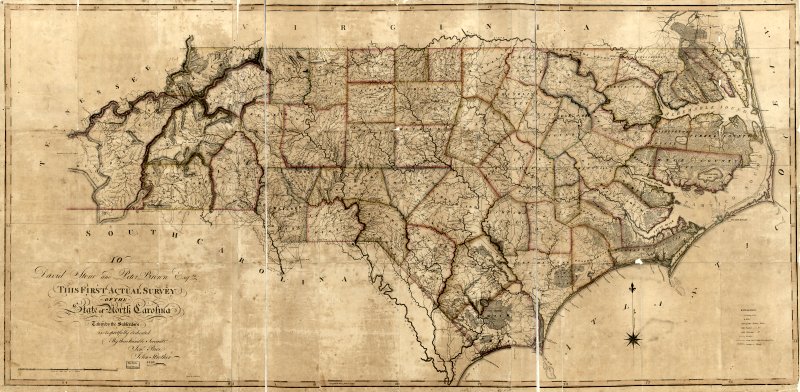
Early map of the State of North Carolina; courtesy Library of Congress.
Our earliest known public record of Alexander Strahan [3] is the inclusion of his signature on one of two petitions, drawn up in 1779, in which the inhabitants of New Hanover, Duplin, and Bladen counties asked the state legislature to approve the formation of a new county. As pointed out in the previous section, the name of Othneil Strahan appears on the other petition.10
In 1790, when the first U.S. census was taken, Alexander Strahan (with surname misspelled "Strayhorn"), was enumerated in Bladen County, North Carolina, with a household consisting of one free white male under 16, one free white male over 16 (Alexander, obviously), three free white females (his wife, obviously, and almost certainly two daughters), and five slaves.11
In the 1800 federal census for Bladen County, Alexander Strahan's family, which was then living in Captain Anders' District, included two free white males under 10, one free white male 10 to 15 (Neill), one free white male over 45 (Alexander), two free white females under 10, one free white female 10 to 15, one free white female 26 to 44 (Alexander's wife Mary, obviously), and twelve slaves.12
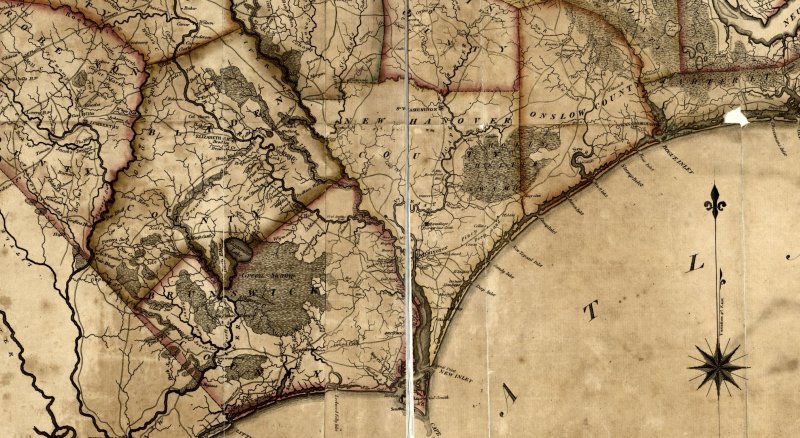
Lower part of North Carolina, showing Bladen and New Hanover counties; courtesy Library of Congress.
At least one of Alexander Strahan's slaves appears to have been especially eager to gain his freedom. On 29 October 1801, the Wilmington Gazette, which was published in neighboring New Hanover County, printed the following notice:
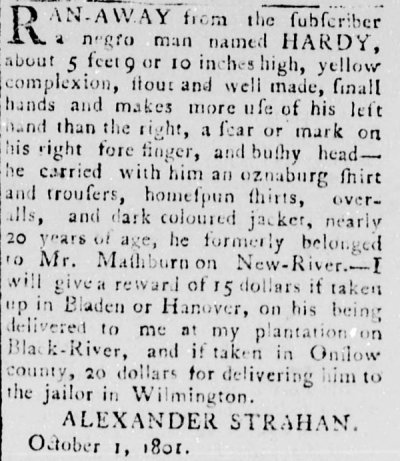
Runaway slave advertisement, Wilmington (NC) Gazette, 180113
Apparently, Hardy was captured and returned to slavery but a little more than a year later, he escaped again. A subsequent notice in the Wilmington Gazette reveals the punishment he suffered for running away the first time (branding with the initials of his master). It also tells us that Alexander Strahan was not the sort of person in which his descendants can take any pride.
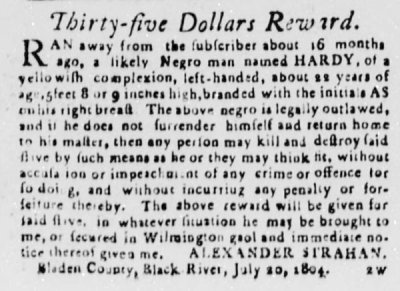
Runaway slave advertisement, Wilmington (NC) Gazette, 180414
Regrettably, these two short notices provide us with only brief glimpses of what was almost certainly an ongoing struggle between a master resolved to exercise full control over one of his slaves and the equal determination of the slave to be free. It would be interesting to know what became of Hardy, whether he was recaptured, killed, or remained at large. The likelihood of his reaching the free states seems remote. Five hundred miles separated Bladen County, North Carolina from Pennsylvania, which was the nearest state where Hardy could hope to avoid being recaptured and returned to slavery; and even if he made it to freedom, article IV of the United States Constitution protected the property rights of slave owners by permitting them to recover runaways no matter where they fled. The nearest place where Hardy could hope to remain free, if he could reach it, was Spanish Florida, where he might find refuge among the Seminole Indians, or in the other direction, Canada. Unfortunately for him, Spanish Florida was just as far as Pennsylvania and Canada was even further.
In the 1810 federal census, the last one in which Alexander Strahan's name can be found, his household included two free white males under 10, one free white male 10-15, one free white male 26-44, one free white male over 45 (obviously Alexander himself), 2 free white females 10-15, one free white female over 45 (Alexander's wife, obviously), and fourteen slaves.15
Owing to the fact that he is not enumerated in the 1820 federal census, it appears that Alexander Strahan [3] passed away sometime between 1810 and 1820. Unfortunately, neither his actual date of death or place of death is known but in all likelihood he died in Bladen County and was buried either on his Black River plantation or in some nearby churchyard.
Some years later, Alexander's widow, Mary, reportedly married a New Hanover County planter named James Moore, whose daughter Anna married Alexander and Mary's son Neill about 1823. It is not known which marriage occurred first but in either event, the result was that Neill's wife was also his stepsister, his father-in-law was also his stepfather, and his mother was also his mother-in-law!
It is believed that following her second husband's death, Mary Moore (Alexander Strahan's widow) went with her son William and his wife to Meriwether County, Georgia, where she may have been living with them when the 1830 federal census was taken, which shows the William Strahan household consisting of one free white male 20 to 30, one free white female 20 to 30, and one free white female 70 to 80 (although it is unlikely that Mary was quite that old at the time).16 It is believed that she died in Chambers County, Alabama in 1842.17
Neill Strahan (Abt. 1797-1866)
Although we have no documents that specifically link the two men, such as a will, it appears likely that Neill Strahan, who was born in North Carolina about 1797 or 1798, was a son of Alexander Strahan [3] of Bladen County and that Neill had at least two brothers, Samuel Strahan, who went to live in Alabama, and William Howard Strahan, who moved first to Georgia, then later to Texas.
About 1823, when he was approximately twenty-six years of age, Neill Strahan married Anna M. (Marie?) Moore, who was the daughter of a North Carolina planter named James Moore. The wedding most likely occurred in either Bladen County or New Hanover County. Although it is not known which union occurred first, Neill's widowed mother was married to his father-in-law. As a result, Neill's wife was also his stepsister, his father-in-law was also his stepfather, and his mother was also his mother-in-law!
On 11 March 1823, Neill (his given name stated as "Cornelius") paid $290 for two hundred and seven acres of land on Ben's Branch in New Hanover County from his father-in-law, James Moore. Both Neill and his wife Anna signed the deed, which was witnessed by John Moore (Anna's brother or uncle, most likely) and a neighbor with the unlikely name of Vanice Bourdeauz.18 This is our only known record that identifies Neill Strahan as "Cornelius" rather than the shorter version of his name, which appears on all subsequent public records.
Sometime before 1830, Neill Strahan and his wife sold the land back to her father19 and removed to Georgia, where they settled in Meriwether County. Neill's brother William also went to live in Meriwether County, before moving to Texas in the 1840s. Another brother, Samuel, went to live in neighboring Chambers County, Alabama.
Although it is obvious that he stayed in North Carolina for at least a while immediately following his marriage, there is some question regarding the whereabouts of Neill Strahan during the entire seven-year period from 1823 to 1830, when he was first listed in the federal census for Meriwether County, Georgia. Part of the problem is that there were two Neill Strahans, both born about 1797 and both living in Georgia at the same time, which several years ago led to no little confusion on the part of this researcher until I finally realized they were two different men and not the same fellow. (See "The Other Neill Strahan" at the conclusion of this essay.)
During the late 1820s the State of Georgia held a land lottery, the purpose of which was "to dispose of and distribute lands lately acquired by the United States for the use of Georgia, of the Creek nation of Indians by a treaty at Indian Springs, 12 February 1825." On the ninth day's drawing, 16 March 1827, Neill Strahan of Butts County was one of the "fortunate drawers."20 It is not known however, whether this man was "our" Neill Strahan or the "other " Neil Strahan (See "The Other Neill Strahan" at the conclusion of this essay.)
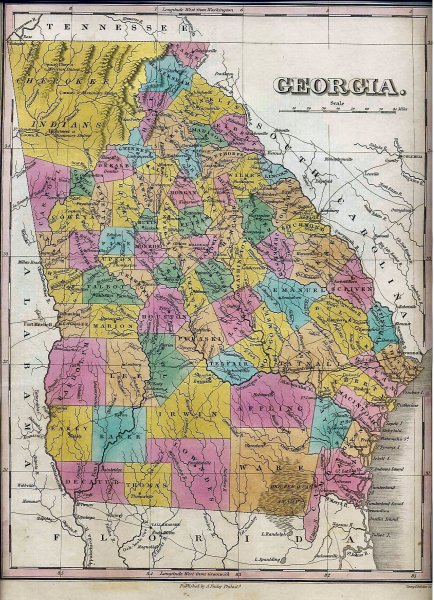
1831 Map of Georgia; courtesy Library of Congress.
Neill and Anna (Moore) Strahan had eight children:
- Sarah Jane (born 25 January 1826; married Henry L. Thomas)
- James Alexander (born 13 June 1829 ; married Caroline Harris)
- Rebecca Ann (born 12 August 1829 ; married Martin Van Buren Thomas)
- C. (Charles?) Henry (born about 1830)
- Mary Caroline (born 20 November 1831; married first William R. West, second Harrison Tate)
- Catherine E. Strahan (born 1834; married William Key)
- Martha F. (born 1838; married first Tilman Hale, second James F. Norris)
- John Neil (born December 1839; married Georgianna Shepard)
If the reader has not already noticed it, there is a problem with the birth dates of two of the children, James Alexander and Rebecca Ann, above. Since it is obviously not very likely that Anna Strahan gave birth to one child in June and then a second child two months later, one of those dates must be erroneous. Unfortunately, both are literally engraved in stone, where brother and sister are both buried in Johnson Station Cemetery in Arlington, Tarrant County, Texas, and there are no other sources to draw upon except census records, which suggest that James may have been born in 1828 instead of 1829.
Unfortunately, census records can sometimes provide confusion as well as clarification. In 1830, for instance, Neill Strahan (surname misspelled "Stayhan") was enumerated in the federal census for Meriwether County, Georgia with a household that consisted of one free white male under 5 (James Alexander, newborn), one free white male from 30 to 39 (Neill, age thirty-eight or thirty-nine), one free white female under 5 (Rebecca, newborn, or Sarah Jane, age four), one free white female 20-29 (Neill's wife, Anna), and one slave-a male less than 10 years of age. However, the census shows that there were also two free white females ages 5 to 9 in the family-that is, born between 1821 and 1825,21 and either Sarah Jane, born in 1826, or Rebecca, born in 1829, is unaccounted for since there is only one female marked in the under 5 column. As for the two girls born between 1821 and 1825, the question naturally arises: Who are they?
In addition to census records, there are deeds on file in the courthouse in Greenville, Georgia that also verify the presence of Neill Strahan in Meriwether County. The earliest of these deeds, which is dated 20 August 1833, shows that Neill Strahan bought 202 and one half acres of land in LL79, 8th District, from a man named Silas Monk. (This deed is found in Deed Book C, p. 63 and p. 64.) A little less than two years later, on 16 January 1836, he purchased 101 and one-quarter acres of land in Meriwether County from Alfred Finley, in LL50, 8th district. (This deed is found in Deed Book H, p. 55.)Finally, on 11 December 1855, he increased the size of his property by purchasing 129 acres in LL49-50, 8th District, from a fellow named James Brown, bringing his total acreage to 432 and three-quarters acres.(This deed is found in Deed Book I, p. 135.)22
In the 1840 federal census for Meriwether County, Georgia, the Neill Strahan household included one free white male under 5 (John, newborn), one free white male age 5 to 9 (James was reportedly eleven, so who is this?), one free white male from 40 to 49 (Neill, age forty-seven or forty-eight), two free white females under 5 (Martha, age two, and ?), one free white female age 5 to 9 (Mary Caroline, age nine, or Anna, age six), one free white female age 10 to 14 (Rebecca, age eleven), two free white females age 15 to 19 (who?), one free white female 30 to 39 (Anna), and three slaves-two males age 10 to 23, and one female age 10 to 23.23 Again, we have the mystery of the two unaccounted for girls, this time in the age group 15 to 19 (born between 1821 and 1825). There is also the problem of Anna, age six, who is unaccounted for unless she is the one female listed in her age group (5 to 9) and it is Mary Caroline who is unaccounted for. We have the further problem of a male, age 5 to 9, who doesn't match our existing data for James. In short, there are four discrepancies, which may simply be due to an error on the part of the census taker or the person who provided the information. Unfortunately, we have no way of knowing whether the Neill and Anna Strahan family had more or less children than we believe to be the case or if someone simply made a mistake in the record.
Sometimes, there are no records of at all. Although there is no question that Neill and Anna Strahan's twenty-six-year-old daughter Sarah Jane married Henry Lewis Thomas on 1 February 1849, there is no evidence of it in the courthouse. However, federal census records confirm that the young couple continued to live in the area for a while afterwards and that about 1855 they moved to Columbia County, Arkansas, where Thomas' parents and other family members also went to live.
In the 1850 federal census, the first in which all members of the household were identified by name, the Neill Strahan family consisted of Neill, age 50 (which is almost certainly an error since he is supposed to have been 52 or 53 at this time), Anna A., age forty-eight, Rebecca, age twenty-one, Mary C., age eighteen, Catherine, age sixteen, Martha, age twelve, and John, age ten. This census shows that Neill and his wife were both born in North Carolina and that all the children named were born in Georgia. It indicates further that Neill owned real estate valued at $2,400, which was a considerable sum of money at that time. His occupation is shown as farmer, the same as almost all his neighbors, which is hardly surprising in a society that was then mostly rural and agricultural in nature.24 A separate census slave schedule shows that he then owned ten slaves: one black male age 36; one black female age 30; one black male age 25; one black female age 20; one black female age 16; one black female age 7; one black male age 4; one black female age 3; one black female age 2; and one black male age 1.25 The slave schedule differentiated between slaves who were entirely African, using the letter "B" to designate them as "black," and those of partly white ancestry, calling them "mulattoes" and using the letter "M" to so designate.
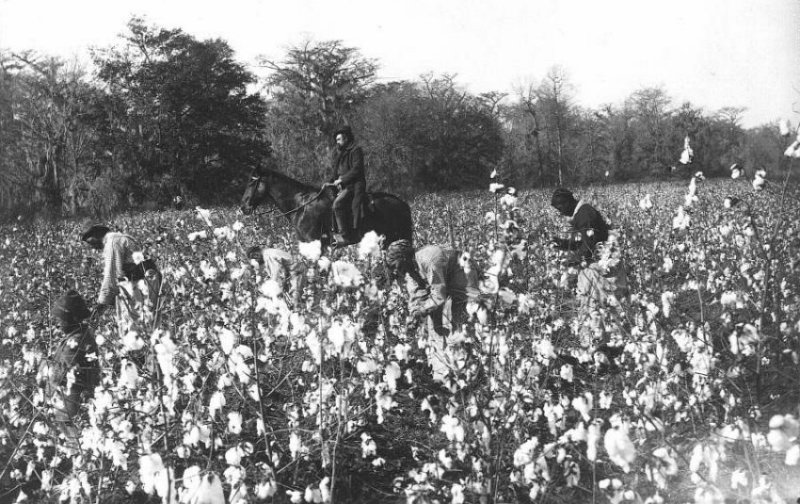
Slaves picking cotton; source uncertain.
In 1855, an author named George White wrote a book titled Historical Collections of Georgia, which included some interesting information about Meriwether County. Formed from Troup County in 1827, which was either just before or around the same time that the Strahan family settled there, the county was named for General David Meriwether,26 who fought in the Revolutionary War and later served in the United States House of Representatives from Georgia. From 1797 to 1800, Meriwether was Speaker of the House.
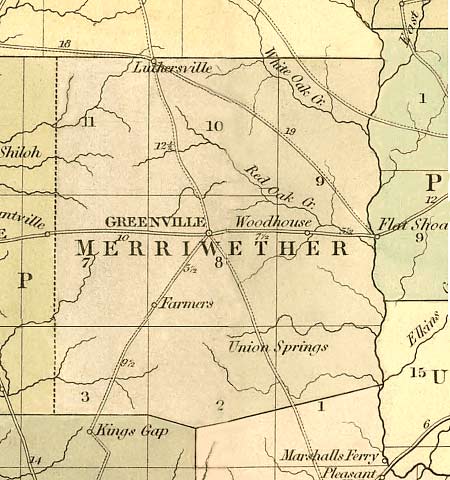
1839 Map of Meriwether County, Georgia; courtesy Library of Congress.
The Flint River, reported White, was "the principal stream" in Meriwether County. He also noted that the "surface of the county is undulating" and that the "Pine Mountains," which "rise in this county W. of the Flint River," provided "a variety of picturesque scenery." White remarked further that "good lands are found, particularly on Flint River, and Red and White Oak creeks."27
In 1855, reported White, Meriwether County was 26 miles and 17 miles wide. Its seat was (and still is), the town of Greenville, which was named for the Revolutionary War hero, General Nathaniel Greene. It was located, he wrote, "nearly in the centre of the county, on a high ridge, on the waters of Walnut Creek, 108 miles from Milledgeville." Other towns included Sandtown, "ten miles from Greenville," and Flat Shoals, "twelve miles east of Greenville." The climate of the county was reportedly "temperate, but subject to frequent changes." White remarked further that Meriwether County was "celebrated for its valuable medicinal springs," which were "situated on a spur of the Pine Mountain 36 miles from Columbus." These warm springs, which inspired the name to another Meriwether County town, included a "fountain gushing forth 1,400 gallons of water per minute, of 90 degrees temperature," making them one of "the greatest wonders in Georgia." Already, there were "fine" bathing houses "and every arrangement…made to accommodate visitors,"28 one of which in the 1920s was a New York politician named Franklin D. Roosevelt, who had lost the use of his legs after contracting infantile paralysis or polio, as it was more commonly known, in adulthood. Roosevelt made frequent visits to Meriwether County until the end of his life, which occurred there on 12 April 1945 while he was serving his fourth term as President of the United States.
In 1850, added White, there were 1,428 dwellings in the county, occupied by as many families, and 824 farms. There were, according to the latest census data, 4,269 free white males and 4,212 free white females, making a total free white population of 8,481. There were only two free blacks, one of each sex. There were also 7,993 African-American slaves, for a total population of 16,476.29 White did not mention it but the ratio of free to slave in Meriwether County was nearly one-to-one (52 percent free and 48 percent enslaved).
On 21 November 1850, one day after her nineteenth birthday, Neill and Anna Strahan's daughter Mary Caroline married William R. West, the only son of Jeremiah and Sarah West of neighboring Harris County.30 Shortly after, on 13 February 1851, Neill and Anna's daughter Catherine married William Key.31
During the latter half of the decade, there were more weddings. On 28 September 1854 daughter Ann Strahan married Martin Van Buren Thomas32 and on 28 July 1857, Neill and Anna's nineteen-year-old daughter Martha married a young man named Tillman H. Hale,33 who unfortunately lived only long enough to father a son who was born in Alabama (where the young couple had gone to live), before Tillman passed away sometime before the spring of 1860, when the federal census was taken.
In 1858, Mary Caroline West, Neil and Anna Strahan's second oldest daughter, was likewise widowed when her husband died at the age of thirty, almost certainly unexpectedly and of some cause that has been lost to history. His place of burial is likewise unknown. Unlike her sister Martha, however, Mary Caroline did not return to her parent's farm but remained in the Harris County home she had made with her husband and two children, Sarah (my great-grandmother) and Henry.
The 1860 federal census for Meriwether County, Georgia found the Neill Strahan household consisting only of Neill himself, age 62, Anna, age 55, and Neill and Anna's widowed daughter Martha, 26, and her infant son Tillman Hale, Jr., age 1.34 Census records also reveal that by this time Neill was a fairly prosperous planter with $1,744 worth of real estate and $10,500 worth of personal property, which consisted largely of eighteen slaves: one black male, age 50; one black female, age 40; one black male, age 39; one mulatto female, age 35; one black female, age 17; one mulatto female, age 14; one black male, age 14; two black males, age 10; one black male, age 6; one black female, age 6; one black female, age 4; one black male, age 4; one black female, age 2; two black males, age 1; and two black females, age 1.35
On 1 June of that same year (1860), Neill and Anna's son John N. Strahan married Georgianna Shepard36 and nearly two years later, on 26 May 1862, Mary Caroline married an Alabama widower, Harrison Tate, in Russell County, Alabama.37
In November 1860, although he had been kept off the ballot in eleven slaveholding states, the Republican nominee, Abraham Lincoln, was elected President of the United States with forty-percent of the popular vote and fifty-nine percent of the electoral vote. There had been three other contenders: John Bell, Constitutional Union Party, who took his home state of Tennessee along with Kentucky and Virginia; Stephen A. Douglas of Illinois, a Northern Democrat who won only Missouri; and John C. Breckenridge of Kentucky, who failed to take his home state but won the electoral votes of the remainder of the South, including Georgia, where nearly 52,000 men (about 49 percent) voted for Breckenridge, nearly 43,000 for Bell (about 41 percent), and nearly 12,000 for Douglas (about 10 percent).38 There is no way for us to know how Neill Strahan voted but it seems likely that he went for Breckenridge, who was the favorite of slave owners across the South.
Fearing that Lincoln would try to abolish slavery, even though the Republican position was merely to restrict its spread into the western territories, slaveholding states began to secede from the Union, starting with South Carolina in December 1860.
Unlike the other slave states, where secession seems to have been a foregone conclusion, Georgians were almost evenly divided. Nevertheless, at a secession convention held in late January 1861, the vote to secede was 208 to 89. A month later, Georgia became one of seven seceded southern states (the others were South Carolina, Florida, Alabama, Mississippi, Louisiana, and Texas) to join the newly formed Confederate States of America. In the spring, after Lincoln was sworn into office, four states of the Upper South (Arkansas, Tennessee, North Carolina, and Virginia) left the Union and joined the Confederacy, for a total of eleven. Four slaveholding "border states," Missouri, Kentucky, Maryland, and Delaware, did not secede, although there were large numbers of Confederate sympathizers in each.
In 1863, when a tax digest of Meriwether County was compiled, it revealed that Neill Strahan owned 433 acres (which was erroneously shown as lying in LL79 in the 9th rather than the 8th District) worth $4,710, town property worth $1,000, as well as twenty-one slaves valued at $20,900 total, that he employed three hired hands between the ages of twelve and fifteen and eight hired hands between the ages of fifteen and fifty-five, that he had miscellanous property valued at $2,960, and that the aggregate value of all his taxable property was $29,570, before subtracting the standard $200 deduction that was given to all county tax payers. (With a tax rate of one percent, his annual property tax came to $297.60). The tax digest also reveals that although he produced five bales of cotton, his principal crop that year was corn (1,200 bushels), which was probably due to the Union blockade that made cotton production unprofitable and the almost certain increased value of food crops.39
It is a certainty that that Neill Strahan did not "join the colors." Being over sixty years of age, he was exempt from military duty. However, his eldest son, John Alexander Strahan, who had gone to live in Northern Louisiana, served as a Confederate surgeon with the rank of lieutenant.40 We also know that a J. N. Strahan enlisted in 1861 at Niblett's Bluff, Louisiana, as a private with the 5th Texas Infantry41 and that he served throughout the war. We also know that a J. N. Strahan was living in McLennan County, Texas after the Civil War42 but in both cases, we cannot be sure if this man was Neill's son,. Since there seems to be record of C. Henry Strahan ever getting married or serving in the military, it seems likely that he died before reaching adulthood.
At the conclusion of the Civil War in 1865, the South's economy was in shambles, particularly in Georgia, where Union General William Tecumseh Sherman's "total war" tactics had left a swath of destruction from Atlanta to Savannah. Fortunately for Neill Strahan and his neighbors, Meriwether County was not in Sherman's path. Nevertheless, it is not hard to imagine, in view of the battles that were fought in Northern Georgia, such as Chickamauga, and the Union Navy's blockade of the Confederacy's coastline, that the market for cotton was hard hit.
Although his slaves were almost certainly overjoyed that the end of the war signaled the beginning of their freedom, it is quite evident that the Civil War financially ruined Neill Strahan. A younger man might have shrugged and started over but in 1865, Neill was sixty-eight years old. On 16 February 1866, he and his wife sold their entire property (a little under 433 acres) to Madison Reeves of Meriwether County for a dollar an acre.43 (This deed is found in Deed Book M, p. 158 and p. 159.) And then, in the company of their recently-remarried daughter Martha and her new husband James F. Norris, they traveled 578 miles — probably in a covered wagon — to Magnolia, Columbia County, Arkansas, where two of Neill and Anna's daughters and sons-in-law, Sarah Jane and Henry L. Thomas and Rebecca Ann and Martin V. Thomas, had been living since the mid-1850s.
If Neill Strahan and his wife Anna looked forward to making a new life among their children and grandchildren, it was not to be. Sometime shortly after completing the journey, first Neill and then Anna passed away. Unfortunately, there seems to be no record of where they were buried and so far, all efforts to find their graves have been unsuccessful.
After four years, Martha and James Norris moved on Tarrant County, Texas. Eventually, so did Sarah Jane and Rebecca and their husbands and family.
Although a 2001 research trip to Magnolia, Arkansas, to try to find Neill or Anna's grave was fruitless, I think I may have been more successful finding the place where my ancestor spent most of his adult life. On 18 August 2004, during a road trip through several southeastern states including Georgia, my son Benjie and I attempted to locate Neill Strahan's property, guided by a modern topographical map supplied to me by another researcher, Riley Strahan, on which he had drawn the outlines of the property after comparing modern maps, nineteenth century maps, and descriptions of Neill Strahan's property, as given in Meriwether County deed records. Consequently, Benjie and I had no trouble finding the spot, which is situated about six or seven miles southeast of Greenville, on Cedar Rock Road. Imagine our amazement however, when we spotted an antebellum mansion on the site, complete with white columns and looking like something straight out of the book or motion picture "Gone With the Wind."
Naturally, we stopped, and I knocked on the door to ask the owner's permission to take photographs. The owner, James E. Collins, Jr., told me it had been in his family for many years, although not as far back as the Civil War, and that he believed the house was built about 1831 and that he had a book of some kind in which it was listed but unfortunately he was unable to find it. Although he could not confirmwhether the house was originally the property of Neill Strahan, I am convinced that it was, in view of the location, which exactly matched Riley Strahan's map. I would like to be certain however, and hope to find some corroborating evidence some day. Unfortunately, the house is not listed on the National Register of Historic Places and information about the property from the county tax assessor's office does not state the year built.
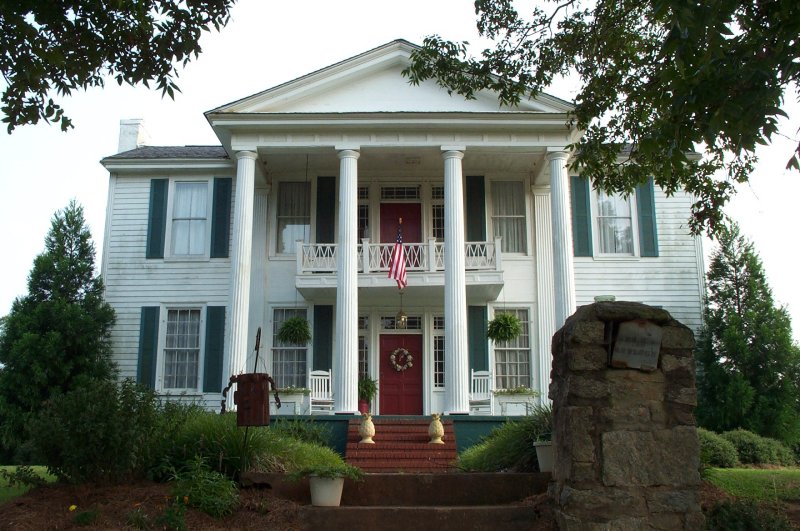
This may be Neill Strahan's plantation house in Meriwether County, Georgia.
The "Other" Neill (or Neil) Strahan
When I first began researching the life of my ancestor Neill Strahan, I was led astray, so to speak, by the fact that initially unknown to me, there were two Neill (or Neil) Strahans living in Georgia at the same time that also happened to be the same age. Not surprisingly, for quite a long time I confused the two men until one day, I realized that some of the evidence I thought I had for my ancestor did not "add up." Fortunately, I finally figured it out.
The "other Neill (or Neil) Strahan" was reportedly the son of Moses Strahan, who is believed to have been a brother of Alexander Strahan, the father of "my Neill." Consequently, the two Neills (or Neils) were almost certainly cousins and both seemingly named for their grandfather, Othniel Strahan.
Although the "other Neill (or Neil)" was about the same age as "my Neill," he is was reportedly born in Effingham County, North Carolina and apparently moved at a much earlier age to Georgia, where during the War of 1812, he (the "other Neill (or Neil") was drafted into Captain H. Everett's company, Georgia militia.
In 1826 the "other Neill (or Neil)" married Nancy A. Alderman in Screven County, Georgia and then moved to Hancock County, Mississippi, where he lived for many years before moving to Washington Parish, Louisiana, where he died in 1887.
NOTES
1William L. Saunders, ed., The Colonial Records of North Carolina, Vol. II-1713 to 1728 (Raleigh: P. M. Hale, Printer to the State, 1886), 541; William L. Saunders, ed., The Colonial Records of North Carolina, Vol. IV-1734 to 1752 (Raleigh: P. M. Hale, Printer to the State, 1886), 330.
2Margaret Hoffman, ed., Colony of North Carolina, 1735-1764, Abstracts of Land Patents, Vol. One (Weldon, North Carolina: Roanoke News Co., 1982), 290.
3Saunders, The Colonial Records of North Carolina, Vol. IV-1734 to 1752, 711 & 884.
4Walter Clark, ed., The State Records of North Carolina, Vol. XXV, Laws 1789-1790 and Supplement, Omitted Laws 1669-1783 (Goldsboro, North Carolina: Nash Brother, Book and Job Printers, 1906), 481.
5Acts of the North Carolina General Assembly, 1749, North Carolina General Assembly, September 26, 1749-October 18, 1749, Vol. 23, 329.
61763 Bladen County, North Carolina Tax List (Signal Mountain, Tennessee: Mountain Press, n.d.), 6.
7There are also extant Revolutionary War military and pension records for a certain David Strahan, who enlisted for service in Wake County, North Carolina but unfortunately, these do not state his relationship to anyone other than his wife, who received his pension after he died in Illinois in the early nineteenth century. Consequently, we cannot be sure these other records pertain to the same David Strahan whose name appears on the tax list of Bladen County for 1763.
8
9Minutes of the North Carolina House of Commons, North Carolina General Assembly, October 18, 1779-November 10, 1779, Vol. 13, 939.
10Unfortunately, I have been unable to find a copy of this second petition.
11U. S. Dept. of Commerce, Bureau of the Census, First Census of the United States, 1790: Population, Bladen County, North Carolina, page 81, NARA microfilm publication M637, roll 7, image 394.
12U. S. Dept. of Commerce, Bureau of the Census, Second Census of the United States, 1800: Population, Bladen County, North Carolina, page 50, NARA microfilm publication M32, roll 31, image 60.
13Wilmington Gazette, 29 October 1801, 3.
14Wilmington Gazette, 7 August 1804, 3.
15U. S. Dept. of Commerce, Bureau of the Census, Third Census of the United States, 1810: Population, Bladen County, North Carolina, page 208, NARA microfilm publication M252, roll 42.
16U. S. Dept. of Commerce, Bureau of the Census, Fifth Census of the United States, 1830: Population, Meriwether County, Georgia, page 151, NARA microfilm publication M19, roll 19.
17This information was obtained in 1999, by email from Billy Strahan, who claims to possess a family Bible so stating. I have never seen it, however.
18
19
20Official Register of the Land Lottery of Georgia, 1827, 23.
21U. S. Dept. of Commerce, Bureau of the Census, Fifth Census of the United States, 1830: Population, Meriwether County, Georgia, page 154, NARA microfilm publication M19, roll 19.
22I do not have these deed records. This information was shared with me by another Strahan descendant, Steve Norris, who sent it to me by email (in 1999) after conducting research in the Meriwether County courthouse.
23U. S. Dept. of Commerce, Bureau of the Census, Sixth Census of the United States, 1840: Population, Meriwether County, Georgia, page 128, NARA microfilm publication M704, roll 46, image 846.
24U. S. Dept. of Commerce, Bureau of the Census, Seventh Census of the United States, 1850: Population, Meriwether County, Georgia, page 371B, NARA microfilm publication M432, roll 77, image 335.
25U. S. Dept. of Commerce, Bureau of the Census, Seventh Census of the United States, 1850: Slave Schedules, Meriwether County, Georgia.
26George White, Historical Collections of Georgia (New York: Pudney and Russell, 1855), 556.
27Ibid.
28Ibid., 557.
29Ibid.
30Meriwether County courthouse, Greenville, Georgia, Marriage Book B (1843-1866), 95.
31Meriwether County courthouse, Greenville, Georgia, Marriage Book B, (1843-1866), 103.
32Meriwether County courthouse, Greenville, Georgia, Marriage Book B, (1843-1866), 143.
33Meriwether County courthouse, Greenville, Georgia, Marriage Book B, (1843-1866), 190.
34U. S. Dept. of Commerce, Bureau of the Census, Eighth Census of the United States, 1860: Population, Meriwether County, Georgia, page 389, NARA microfilm publication M653, roll 130, image 391.
35U. S. Dept. of Commerce, Bureau of the Census, Eighth Census of the United States, 1860: Slave Schedules, Meriwether County, Georgia.
36
37
38Nashville Union and American, November 20, 1860, 3.
391863 Tax Digest for Meriwether County, Georgia, p.97.
40
41
42
43Meriwether County courthouse, Greenville, Georgia, Deed Records, Book M, 158.
|